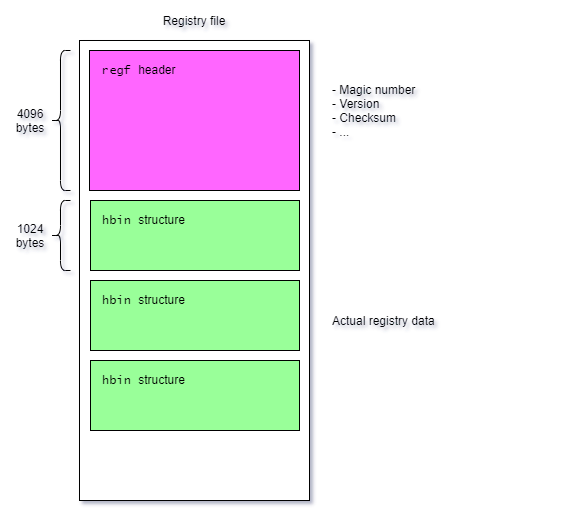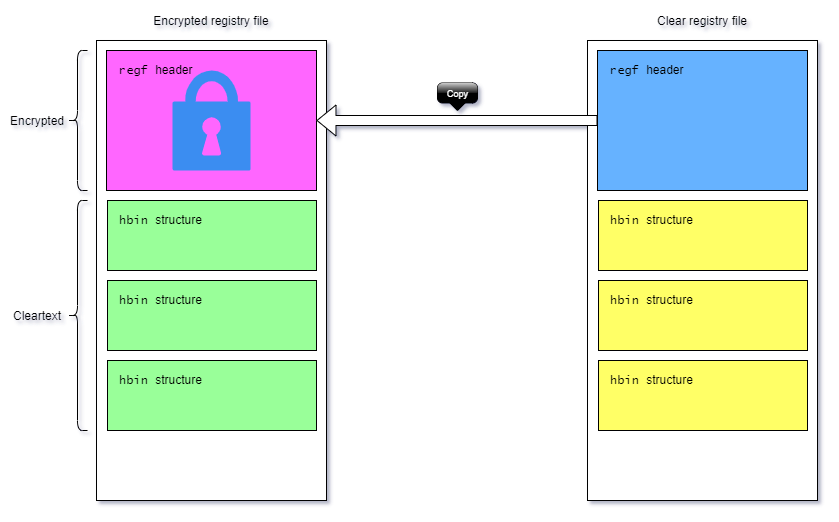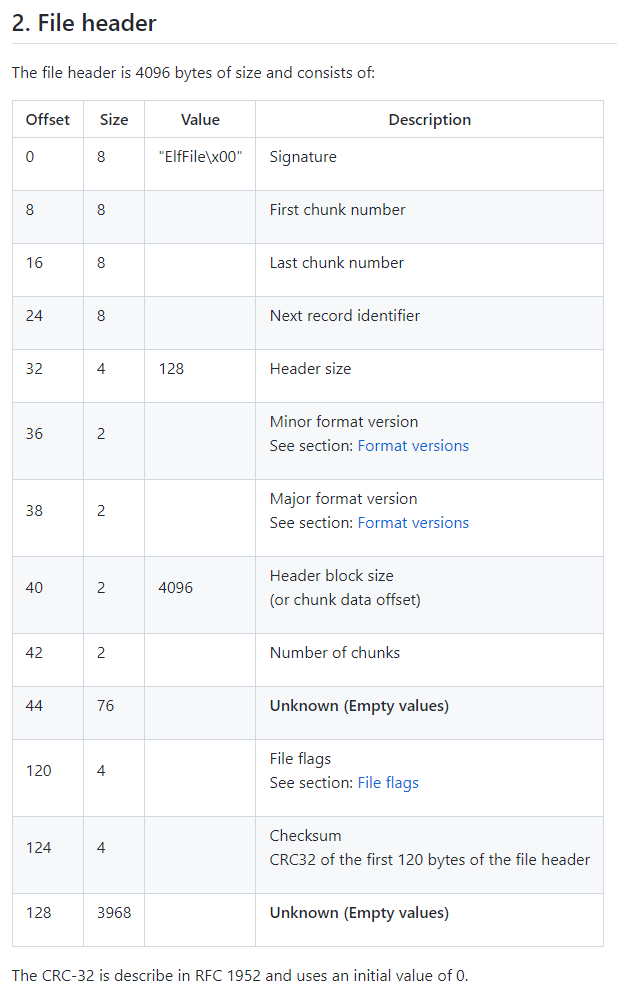The LockBit 2.0 ransomware has been incredibly “productive” these last few months: their technique is well automated, and the list of compromised companies keeps growing every day.
In order to reduce the destructiveness of their payload, most ransomware operators do not encrypt every single file on a system; instead, they set out a set of rules, for example:
- Only encrypt files with specific extensions:
.docx,.cpp,.db,.log - Don’t encrypt files in
C:\Windows\System32, in order to keep a semi-working machine (otherwise how would the users read the ransom note?)
LockBit 2.0 has a pretty interesting quirk though: as an optimization, only the first 4KiB (4096 bytes) of each file are encrypted. This is usually enough to lock away important data and make file recovery a pain. It also speeds up the encryption process.
We have also observed that the LockBit 2.0 ransomware is pretty generous in the extension list it encrypts: even user hive files (NTUSER.DAT) are encrypted, which is a pain if we want to extract useful data from it. But registry hives can be pretty big, could we maybe recover some data anyway?
Registry hive structure 🔗
In order to understand how we can recover the hives, we must first have a look at how registry hives are stored on-disk. Willi Ballenthin’s python-registry has some good explanations, including a text file from a certain B.D. which goes over the structure of hives for both Windows 95 and NT. This document tells us that NT optimized hive loading by making the header the typical size of a page, 4KiB.

This means that LockBit only encrypts the header, and doesn’t touch the actual data of the hive. Is it possible to restore the header? To answer this question, we must list everything the header contains:
- A magic number (
regf) - Sequence numbers (used for inconsistency detection)
- Modification timestamp
- Version numbers
- Hive name
- Hive flags
- Header checksum
Basically, we can see that the header is mostly self-contained: there’s no reference to hbin offset, or a global hive checksum. There should be no problem restoring the header by copying it from another hive of the same type 😊
Restoring the hive 🔗
Simply by copying over the first 4096 bytes from another, clear NTUSER.DAT, we were able to entirely recover all our user hives!

$ regrip.py --ntuser ./ntuser_recovered.dat userassist | wc -l
84
It works! RegRippy will be confused when trying to give you the user names when extracting data from NTUSER.DAT, because it guesses them based on the hive name, which has been copied over from a clean hive. Other than that, everything works as expected, and all data is accessible.
If you ever encounter this issue, here’s a script which can restore an encrypted NTUSER.DAT hive: it’s basically rebuilding the header and replacing it to create a clean hive.
#!/usr/bin/env python3
import argparse
def main():
parser = argparse.ArgumentParser(description="Fix encrypted hives by repairing the header (only for NTUSER.DAT)")
parser.add_argument("--user", type=str, help="The user name to store in the header (default: JohnDoe)", default="JohnDoe")
parser.add_argument("hive_path", type=str, help="Encrypted hive path")
parser.add_argument("output", type=str, help="Where to output the fixed hive")
args = parser.parse_args()
hive_name = "??\\C:\\Users\\" + args.user + "\\ntuser.dat"
encoded_hive_name = hive_name.encode("utf-16-le")
if len(encoded_hive_name) > 64:
encoded_hive_name = encoded_hive_name[:64]
else:
encoded_hive_name += b"\x00" * (64 - len(encoded_hive_name))
header = b"regfH\x1E\x00\x00\x48\x1E\x00\x00\x00\x00\x00\x00\x00\x00\x00\x00\x01\x00\x00\x00\x05\x00\x00\x00\x00\x00\x00\x00\x01\x00\x00\x00\x20\x00\x00\x00\x00\x80\x0E\x00\x01\x00\x00\x00"
header += encoded_hive_name
header += b"\x43\xBE\x11\x44\xFF\x07\xE8\x11\x92\x75\xEA\x28\xA0\xD0\x3E\x60\x43\xBE\x11\x44\xFF\x07\xE8\x11\x92\x75\xEA\x28\xA0\xD0\x3E\x60\x00\x00\x00\x00\x44\xBE\x11\x44\xFF\x07\xE8\x11\x92\x75\xEA\x28\xA0\xD0\x3E\x60\x72\x6D\x74\x6D\xBE\x82\x8C\x05\xB7\xB9\xD7\x01\x4F\x66\x52\x67\x01\x00\x00\x00\x00\x00\x00\x00\x00\x00\x00\x00"
header += b"\x00"*316
header += b"\xD8\xC9\x70\x75"
header += b"\x00"*3584
with open(args.hive_path, "rb") as h1:
with open(args.output, "wb") as h2:
data = h1.read()
without_header = data[4096:]
h2.write(header)
h2.write(without_header)
print("Done! Hive written to", args.output)
if __name__ == "__main__":
main()
(Update) Extending the technique to other file types 🔗
In passing, @citronneur mentioned that EVTX files also had a 4 KiB header. Maybe they could be reconstructed as well?
When investigating Windows file formats, it’s always a good idea to check Joachim Metz’s libyal repositories. In that case, bingo! libevtx exists, with some very detailed documentation.

Basically, an EVTX file is composed of several chunks, and each chunk contains a number of records. Each record has an ID, which is unique across all chunks.
We assume the first chunk number is always 0. To get the last chunk number, we will search for the signature "ElfChnk\x00" and count its occurrences. We assume chunks are numbered in increasing order, starting from zero.
To get the last record ID, we first get the last chunk (easy, because each chunk has a fixed size), and parse the offset to the last record from its header. We then parse the record at this offset to extract its ID.
The checksum is a simple CRC32 of the first 120 bytes of the file header. With this, we are able to recreate all the data from the encrypted file header and read the events!
And here is a Python script which does just that:
#!/usr/bin/env python3
import argparse
import binascii
import sys
def get_number_of_chunks(data):
count = 0
needle = b"ElfChnk\x00"
for offset in range(len(data) - len(needle)):
if data[offset : offset + len(needle)] == needle:
count += 1
return count
def get_chunk(data, n):
data = data[4096:] # get rid of header
print("[+] Getting chunk", n)
chunk = data[n * 65536 : (n + 1) * 65536]
assert chunk[:8] == b"ElfChnk\x00"
return chunk
def get_last_record(chunk):
offset = int.from_bytes(chunk[44:48], byteorder="little")
print(f"[+] Last record offset: {offset} (0x{offset:x})")
if offset == 0:
print("[!] Error: this EVTX file probably has no events")
sys.exit(1)
record = chunk[offset:]
assert record[:4] == b"\x2a\x2a\x00\x00"
return record
def get_record_id(record):
i = int.from_bytes(record[8:16], byteorder="little")
print("[+] Record id:", i)
return i
def main():
parser = argparse.ArgumentParser(description="Fix LockBit2.0 EVTX file")
parser.add_argument("file", type=str, help="Path to evtx file")
parser.add_argument("output", type=str, help="Where to store the resulting file")
args = parser.parse_args()
data = None
with open(args.file, "rb") as f:
data = f.read()
print("[+] Loaded", args.file)
chunks = get_number_of_chunks(data)
print("[+] Number of chunks:", chunks)
signature = b"ElfFile\x00"
first_chunk_number = (0).to_bytes(8, byteorder="little")
last_chunk_number = (chunks - 1).to_bytes(8, byteorder="little")
next_record_id = get_record_id(get_last_record(get_chunk(data, chunks - 1))) + 1
next_record_id = next_record_id.to_bytes(8, byteorder="little")
header_size = (128).to_bytes(4, byteorder="little")
minor_version = (1).to_bytes(2, byteorder="little")
major_version = (3).to_bytes(2, byteorder="little")
header_block_size = (4096).to_bytes(2, byteorder="little")
number_of_chunks = chunks.to_bytes(2, byteorder="little")
unk1 = b"\x00" * 76
file_flags = (0).to_bytes(4, byteorder="little")
crc32 = -1
unk2 = b"\x00" * 3968
header = (
signature
+ first_chunk_number
+ last_chunk_number
+ next_record_id
+ header_size
+ minor_version
+ major_version
+ header_block_size
+ number_of_chunks
+ unk1
+ file_flags
)
crc32 = binascii.crc32(header[:120]) & 0xFFFFFFFF
header += crc32.to_bytes(4, byteorder="little")
header += unk2
assert (len(header)) == 4096
with open(args.output, "wb") as f:
f.write(header)
f.write(data[4096:])
if __name__ == "__main__":
main()